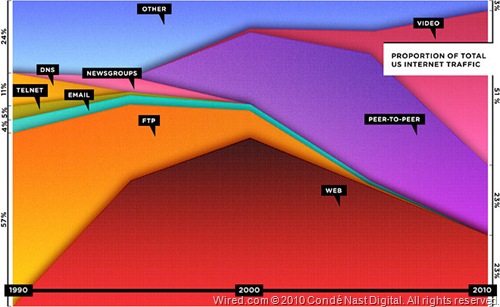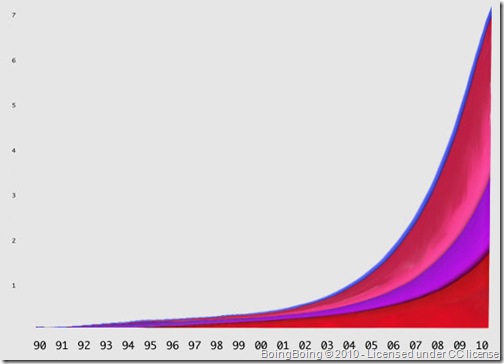Last week Wired published a long article stating that the Web (as in the thing you get through the browser) is dead, while the Internet is evolving.
I think they are totally wrong for a few reasons:
- They prove their statement reading in the stats what they wanted to read: they compare the proportion of traffic instead of the total amount and this leads to the wrong conclusions
- They say the web is being taken over by peer-to-peer and video, based, again, on the bandwidth used
- Most our time is spent on web sites
Proportion of traffic instead of total traffic
Let’s start from the first reason I think they are wrong: they want to prove their statement with a chart that compares the proportion of the traffic instead of the total traffic.
As the title of the chart says, this is the proportion of the traffic (measured in bandwidth) of all internet traffic. What this means is just that now 23% of the traffic is used by the Web, while in 2000, it was around 50%. According to Cisco, the source used by Wired for its “proportion” chart, the total traffic in the same period grew from nearly half a exabyte (500.000 terabytes) to 7 exabytes. And 50% of 0,5 is lower than 23% of 7.
BoingBoing had an excellent post commenting the chart (Is the web really dead?) and they came up with the following chart.
And as you can seem, the traffic of the “Web” is still growing. Just it’s being joined by other way of using the pipes, video and file-sharing.
Video and peer-to-peer are taking over the web
This page, including images and layout has a size of probably 200-300Kb, and the mere post is probably less than 100Kb. How much do you think the size of this post would have been if I had delivered it via a video? I think it would have been around 5-10Mb: at least 50 times more. If the chart was on the amount of information provided instead of the bandwidth used to deliver it, the statement of Wired would have been even less true.
We spend most of our time on the web
The “Web is dead” is probably true if we evaluate how we use the mobile: most of the web sites don’t work on the tiny display of smartphones. So we are forced to use Apps: there is Facebook for iPhone, Twitter for iPhone, there are dozens of newsfeed readers. But on our desktop computer, we are using the browser: all the social network are standard web sites, we buy books and electronics using web sites, we collaborate on opensource projects using web sites, we book flight using web sites, we read most of the blog post on a web site (either the original one or via google reader).
Sure thing, the web is evolving: it’s not just Geocities pages about kittens. It’s more structured information, it’s more e-commerce, it’s more about interaction between people, it’s more about web applications. Well, isn’t this what we used to call Web2.0?
I don’t think Web3.0 will be the dead of the web. Still not sure what it will be, but definitely not its dead.
Looking ahead
This post has grown longer than I originally thought. So thank you for reaching the end, and I’d be pleased if you could comment writing your ideas on the matter.
And last thought of the post: this article clearly shows that Wired is not unlike the other “internet” magazines. Just sensationalism and half-told truths.


